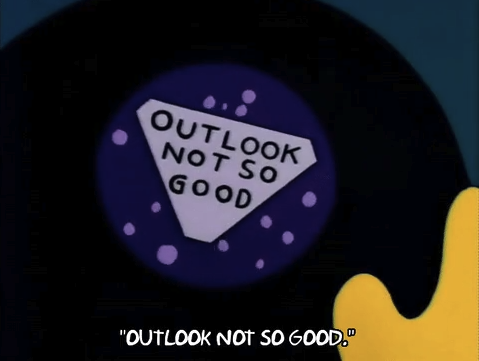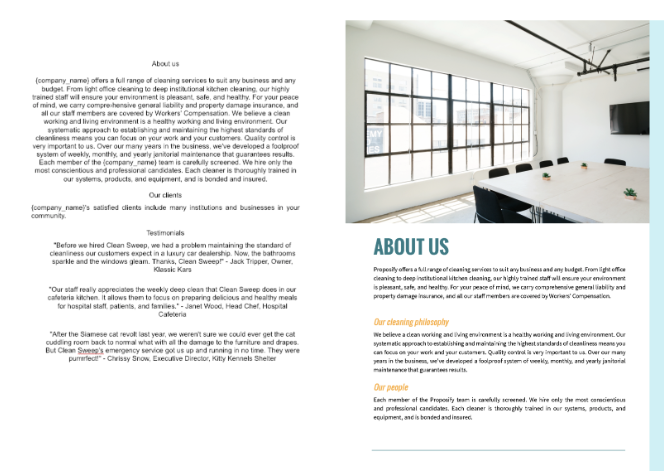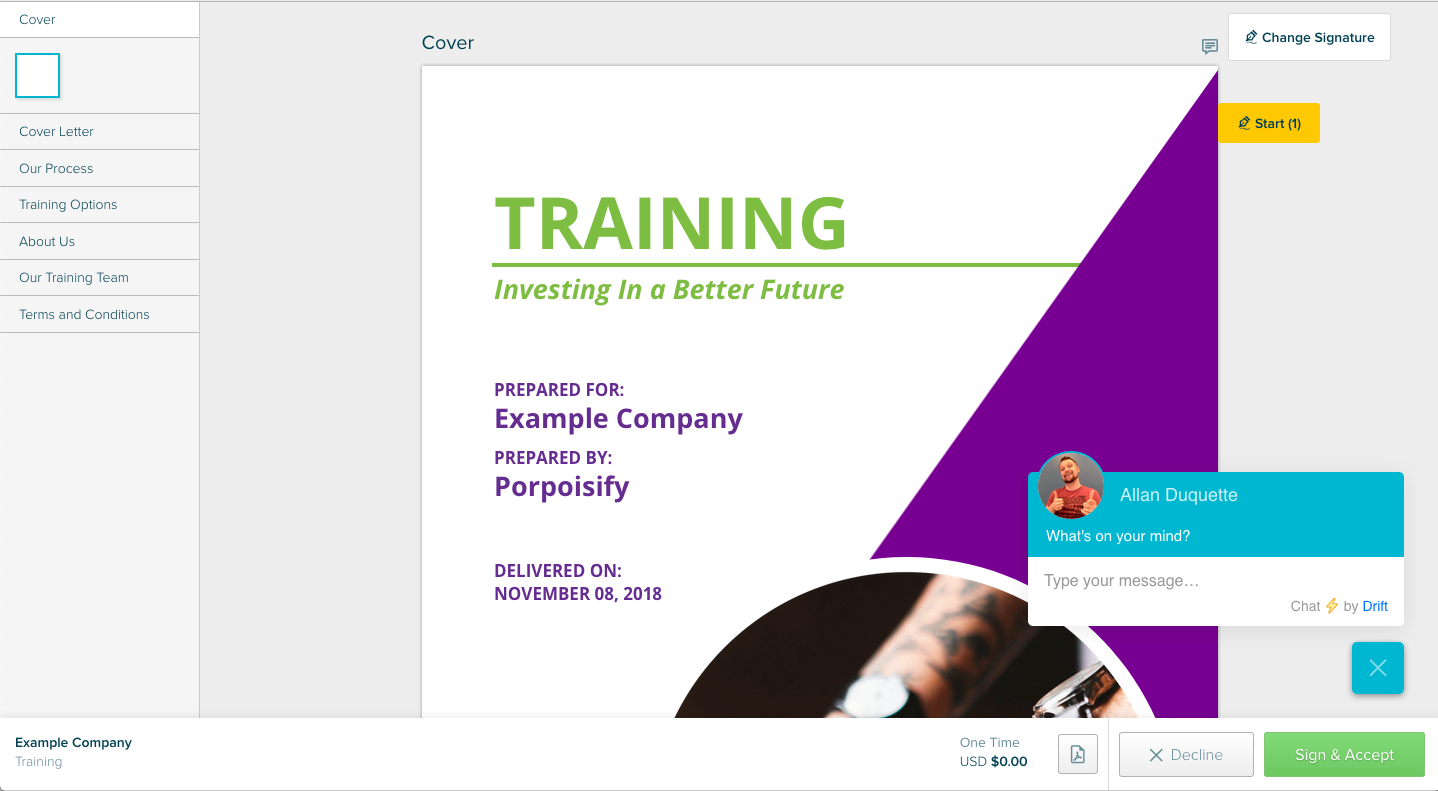7 Proposal Myths to Abandon in 2019
Published: January 8, 2019Updated: July 24, 2024

There are a lot of proposal development myths out there. And if you believe them, you might as well be leaving your proposal win rate up to the whim of a Magic 8-Ball. Let’s give these proposal myths a shake and debunk them before your proposal success forecast is ‘OUTLOOK NOT SO GOOD’.
Boom—instant fortune.

Conjure up your memories of billiard ball-based fortune-telling.
A Magic 8 Ball is fun for posing those crucial junior-high questions, then repeatedly asking until it reveals the answer you were hoping to get.
But you’d never base your sales strategy around something as arbitrary as a die swimming in blue fluid, right?
When you still believe outdated or flat-out false proposal myths, you’re basically using a Magic 8 Ball as your proposal creation compass. And it doesn’t take a psychic to tell you that your proposals won’t be as good as they could be.
Here’s how you can banish those unproductive beliefs and increase your chances of proposal success in 2019.
Myth 1: Recipients read every single word in your proposal.
Unless your proposal recipients work in the procurement department, evaluating new vendors or service providers is probably a task added on top of their regular everyday duties.
Your prospective clients are busy people with jam-packed schedules. Your proposal is one more thing your leads have to turn their limited attention to. This means they’re most likely skimming and scoring your proposal against ones they’ve received from your competitors.
One look at an impenetrable wall of text in your proposal and your recipients will immediately give up and flip to the pricing page. Not good. The Executive Summary, About Us, and other often ‘wordy’ sections are where you showcase your expertise. They’re key for showing the value you provide and shouldn’t be overlooked.
So, instead of assuming that recipients will read every single word, create your proposals with the knowledge that they’re likely to be scanned, not pored over.

Web writing and layout techniques work great for proposals, especially if you’ll be sending your proposal electronically. Use short sentences, short paragraphs, and lots of white space to let the words “breathe.”
Be careful with your text spacing and alignment. For example, a paragraph of left-aligned text is much easier to read than a paragraph of centred text.
Instead of wacky alignment or boring bolding, bring attention to key items to note, like deadlines, obligations, and deliverables with eye-catching elements. Our eyes are naturally attracted to colour and visuals, so be sure to break up text with appropriate photos, graphs, and other images.
Myth 2: Recipients will let you know right away if they have a question about or an issue with your proposal.
If you’re living by the old saying “no news is good news” when you send your proposal as a Word doc or pdf, you’re living in the dark ages.
As in, you’re actually in the dark about whether the prospective client has received, opened, read, or has questions about your proposal.
You have no clue where you stand. And relying on the potential customer to give you an immediate head’s up is asking a lot and risky.
They have to find your contact info and get in touch via phone or email to ask their questions. The client might make the effort. Or they might just move on to the next proposal—the one from your competitor—on their desk.
Then, if you don’t end up hearing from them, you have to guess at the best time to follow up with them. You might be too soon or too late.
Online proposal software like Proposify can remove some of these barriers. For example, you can see exactly when your proposal was received, opened, and read. This saves you from annoying people before they’ve had a chance to take a look or waiting too long to reach out and missing the window of opportunity.
You can also monitor the pages on which the clients are spending the most time so you can see what sections of the proposal they were really interested in or that they may be hitting a wall with, like the pricing page.
An instant chat window right in the proposal lets them contact you with quick questions as they’re reading. They get the information or clarification they need, and you get a better chance of closing the deal with your quick responses.

Myth 3: You write a proposal.
You don’t just write a proposal; you design and develop it, too. Design is an important part of how you communicate.
Of course, clear, concise, and effective writing is vital to a persuasive proposal. But, there are other elements at play.
The amount of care you put into your proposal shows. If you wouldn’t show up to a client meeting in your pajamas, why would you send the document equivalent of sleepwear? A proposal that’s sloppy and unsophisticated doesn’t put your best (non-slippered) foot forward.
Designing your proposals to showcase your brand, style, and professionalism reflects positively on your company, your values, and your commitment to your work.
Some proposal design aspects to consider:
- Keep your branding consistent. This includes your logo, brand colours, as well as the fonts and imagery you choose.
- Use repeating elements, like a bold header image on each page, or a watermark of your logo to create a cohesive package.
- Think about your typography hierarchy. Keep the font size, weight, colour, and other attributes of your titles, subtitles, and paragraph copy consistent. This helps your recipients read and scan your proposal.
If the idea of crafting a beautiful design for your proposal is a little intimidating, don’t worry. Most proposal software offer professionally-designed templates that can be customized to match your brand guidelines, add images, and other design elements.
And if you are more design-inclined, proposal software also makes it easy create your own templates from scratch, helping you keep everything nice and consistent throughout.
Myth 4: Only subject-matter experts should create proposal sections.
If you’re in a highly-technical or specialized field, you’re likely going to have subject-matter experts (SME) contributing to your proposal content. They obviously know a lot. That almost goes without saying. Their expertise will help you build trust with your prospective clients. Knowledge is impressive and everyone wants to impress potential clients.
The SMEs may be great at technical writing or when writing for a similarly specialized audience. But are your SMEs skilled at the type of persuasive writing that your proposal needs?
Language, tone, and style are all key to a winning proposal. It pays to have someone else review submissions from your SMEs. You want someone who is less familiar with the technical side, but well-versed in sales and marketing.
The reviewer could be the salesperson working on the deal or someone from your marketing department. If you have the budget, you could also bring in a professional freelance writer or editor.
In any case, they can review the text and help balance out the SME’s substantial information with a bit of persuasive style and simplified wording. This is particularly helpful if you will be submitting proposals to clients in other industries or who won’t care deeply about your specialized or complex processes or understand the technical lingo.
Even general business cliches that get thrown around with abandon at your office might read like a foreign language to your recipient.
Avoid using jargon-y words and phrases to describe your product or service, like best-in-class, robust, or baked in. (It’ll make you sound like you’re selling a car, roasted coffee, or walnut brownies, respectively.)
Myth 5: Clients will be impressed by a totally “outside-the-box” proposal.
In an ultra-competitive proposal situation, like a request for proposals (RFP), your desire to win could work against you.
With an RFP, there are usually specified requirements and structures. You might think you’ll get in front of the prospect first by sending a quick, basic proposal that doesn’t meet the requirements. Or you might think that you’ll stand out from rule-following competitors by ignoring the stipulations.
A proposal is like a job interview. The job posting says to submit a resume and cover letter in person with no calls please. You email and call them, repeatedly. Guess whose application is going at least to the bottom of the pile, if not right into the trash bin?
It’s the same thing with RFPs and other situations where clients give you instructions for submitting a proposal. Follow them. Yes, even if you don’t agree with them or if the client keeps changing their mind about them.
Many companies have strict guidelines for scoring competing proposals. If yours doesn’t conform to those standards, it may be disregarded or disqualified.
On the other side, even if there are no stated requirements for how a proposal should be structured and submitted, you should still think it through before you send something completely outside the norm.
Unless your company is widely known for its unconventional ways and therefore a wacky proposal would be on-brand, use caution. There’s a fine line between irreverant and irrelevant.
Instead, impress potential clients with your proposal content and design. Make it easy to say yes to substance, instead of easy to say no because of some attention-seeking gimmick. Including a short, well-executed video introducing your company in your digital proposal? That can work. Filling your proposal with funny cat videos? Not so much.
Myth 6: Don’t talk about yourself in a proposal. Focus solely on the prospect.
We can link this myth back to the job application process, too. Picture an interviewee that only talks about themselves: their education, things they’ve done for other companies, their personal achievements.
Now think about someone who only talks about lofty, pie-in-the-sky goals but never provides details or background on how they know they’ll be able to accomplish these things.
Would you hire either of these individuals? Probably not. You’d be better off with an applicant who has lots of ambition and can also show they have the experience to back it up.
When it comes to winning business proposals, the best practice is to make the recipient’s pain points and objectives the priority. That’s still solid advice. You need to talk about how you will solve the client’s challenges.
However, you also need to provide proof that you know what you’re doing and that you’ve delivered on these promises before.
Include social proof, like case studies and testimonials. Make sure they’re recent (as in, created within the past three years, tops) and relevant (similar to the proposed project or in the same industry as your prospective client).
When you’re deciding which case studies to use, look for ones that hit upon different aspects of your business. Maybe one could highlight a cool project that you did for a similar company, while another could showcase your team’s dependability and professionalism.
Speaking of your team—don’t forget to show off the people that will be working on the project and their talents and expertise. This helps clients feel like they’re hiring the best.
Be careful about stacking the about us/team page in your proposal, though. It looks impressive to include the senior manager, department director, or VP. But if you’re including anyone in high-level positions who won’t be directly contributing to the project, be sure to indicate that their role will be managerial or supervisory.
If you don’t, you could be setting yourself up for client dissatisfaction when those top-level employees don’t end up working hands-on on their project.
Myth 7: Offering more than one pricing option in your proposal is too confusing and will turn clients off.
Pricing a proposal is an art and a science. It’s a tricky thing to get right.
Even once you have the project priced out, you could lose the deal if you’re not strategic in how you present your pricing.


